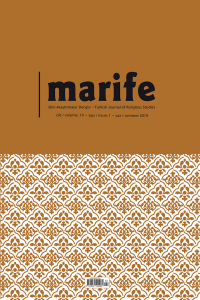
Marife Dini Araştırmalar Dergisi
Yazarlar: Güldane GÜNDÜZÖZ, Soner GÜNDÜZÖZ
Konular:Felsefe
DOI:10.33420/marife.905244
Anahtar Kelimeler:Islamic Philosophy,Taha Abderrahmane,Argument Ethics,Sh̲ahāda,Iʼtimāniyya,Tadāwuliyya (Speech Act Theory)
Özet: Taha Abderrahmane is one of the important philosophers alive today in the Arab-Islamic world. With his theo-political writings he suggested “a deliberative model of political communication and an Islamic media theory in a physical and metaphysical unity”, he constructed a holistic and versatile Islamic methodology in his works. This article focuses on Taha Abderrahmane’s theory -ethical in one aspect and theo-political in the other- of communication and media based on testimony. According to Taha Abderrahmane, human communication is human and collective in one aspect and divine and conscientious in the other as a structure based on metaphysical dimension. This communication network, which requires physical and metaphysical integrity in terms of its references and reaches bazm-i alast (pre-eternal covenant), goes beyond mere inference. Thus, he employs the concepts of inference and witnessing in a balanced way in the field of communication and thus he creates a new negotiation ethics, communication model and an Islamic media theory. In the final analysis, this theory emphasizes that the concepts of conscience, burhan and power should be handled with an integrative understanding. Thus, it is predicted that all human relations will form a homogeneous structure in ethical, aesthetic and epistemological dimensions. In general, religious epistemology has been seen to be neutralized in the field of media as an instrument of democracy and in some communication theories about the concept of deliberative democracy developed by libertarian theorists. One of these theories is Habermas’s theory of communication, which Taha Abderrahmane made the subject of examination and comparison due to its emphasis on the collective nature of the negotiation. Indeed, indifference towards religion is a frequent occurrence in civil libertarian interpretations of democracy that have evolved into deliberative democracy, such as that of Jürgen Habermas. However, in deliberative democracy, non-state negotiation areas are seen as a communication field. In addition, elements such as media, social media tools and associations are considered as a stakeholder of social communication, similar to the parliament, which is the official negotiating body of the state. On the other hand, indifference to the phenomenon of religion creates a paradoxical situation. To establish an Islamic communication model and media theory, Taha Abderrahmane has benefited greatly from Jürgen Habermas’s communicative action theory, one of the important representatives of negotiation democracy, but he also made serious criticism of this theory. The hadīth of qurb al-nawāfil, which adds a mystical aura to Taha Abderrahmane’s theory, is a holy hadīth, states that the servant, who is attached to Allah with submission and sincerity, will feel the grace and protection of Allah at any moment. This hadīth is mostly accepted in ṣūfī circles. Taha Abderrahmane takes the Islamic knowledge base as a reference and works on the production of Islamic thought through historical memory. However, he did not regard this accumulation as a field based solely on collective and human consensus in this method. Rather, Taha Abderrahmane relied on the metaphysical memory in which man carried his memory in his own depth. Therefore, the knowledge production and communication processes of the Islamic society are also related to the concept of witnessing, which contains strong references to the conscientious dimension, which cannot be based solely on argumentation. One of the most important aspects guiding Taha Abderrahmane’s works is word-action theory, based on a linguistic paradigm. Although Abderrahmane has taken Western sources as reference in many ways with this theory, he constructs a pragmatic approach quite different from the Western one. He built a holistic and versatile Islamic methodology in his works. It constitutes a world of thought in the axis of i’timāniyya (divine contract and trust paradigm) and tadāwuliyya (pragmatic-word-action theory). Like the concept of witnessing, Taha Abderrahmane used this epistemological field, which forms the basis of the word-action theory, as an instrument in his communication model. This epistemological field includes the testimony of traditional Arabic poetry and literature and also accepted the fields of ʿilm al-naḥw, balāḡa and sunna as reference information. This epistemological field includes areas such as philosophy and logic as transfer knowledge.